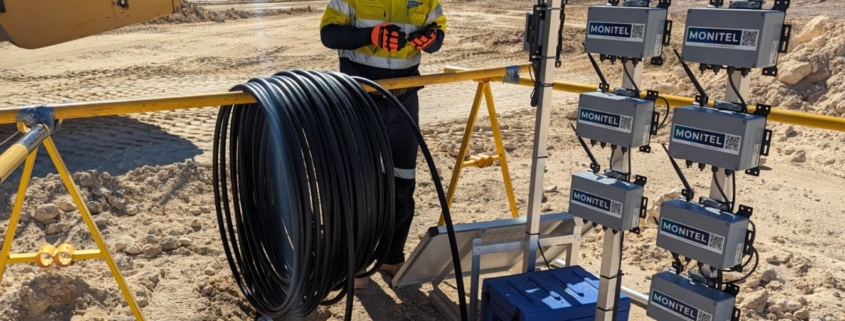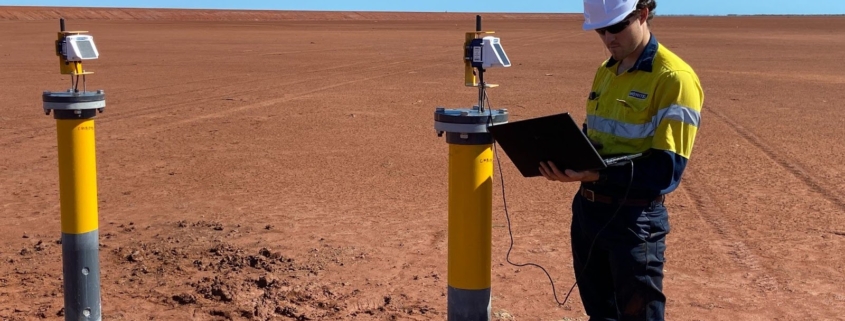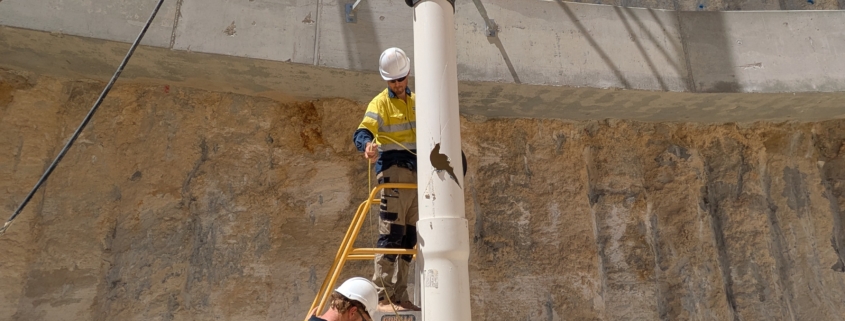When installing a piezometer, engineers want to set it up for long-term performance, stability and safety. A critical (but often overlooked) step in that process is potting.
At Monitel, we pot our sensors with methods that are proven to hold up in Western Australia’s harshest conditions. Integrated into wider monitoring systems, our units support high-integrity data collection over vast periods of time.
In this article, we explain what piezometer potting is, why it’s essential in geotechnical installations and how we tailor our processes to meet the demands of site conditions and regulatory requirements.
What Is a Piezometer?
A piezometer is a sensor used to measure pore water pressure within soil, rock or other geological materials.
Piezometers are commonly installed in boreholes, tailings dams and excavation sites to track long-term changes pressure. Their data can be critical in understanding subsurface stability and geotechnical risk. That might include slope failures, foundation movement or structural instability.
Monitel supplies and installs a range of piezometer types suited to different applications, including vibrating wire, standpipe, strain gauge and pressure transducer models.
What is Potting?
In the context of piezometers, potting refers to the process of sealing the electrical connection point between the sensor and its signal cable. This is typically done using a resin compound designed to:
- Protect against water ingress
- Secure the internal wiring
- Provide mechanical strain relief
- Prevent sensor failures caused by corrosion or movement
Potting keeps the sensitive interface between sensor and cable fully sealed from the elements. That’s what secures accurate readings in long-term and deep installations.
Why Does Potting Matter?
1. Waterproofing and Moisture Protection
Even the smallest gap at the cable junction can allow moisture into the sensor body, corrupting readings and causing signal failure. This is especially true for a vibrating wire piezometer, which relies on signal consistency to monitor subtle changes over long periods.
Our team use potting compounds rated for high humidity and full submersion, essential for protecting installations in saturated boreholes, tailings dams or groundwater monitoring wells.
2. Strain and Vibration Resistance
In remote or geotechnically active environments, piezometers must withstand movement, vibration and cable tensions. Potting prevents any of these being transferred to the sensor connection, reducing the risk of long-term fatigue and detachment.
If your site is experiencing heavy vehicle traffic, blast vibration or ongoing settlement, these benefits are particularly important to your sensors’ lifespans.
3. Chemical and Thermal Durability
Whether they’re home to mining, landfill or infrastructure projects, many WA sites endure aggressive chemical and temperature conditions. At Monitel, we select potting compounds that resist chemical degradation and fluctuations caused by high temperatures.
How Monitel Implements Best Practices in Potting
At Monitel, we don’t treat potting as an afterthought. It’s built into our wider installation process and includes:
- In-field potting stations that allow us to immediately seal sensors during deployment.
- Sensor-specific materials are matched to the piezometer type and site conditions. That ensures your whole system is self-integrated.
- Documented quality assurance with photographic records and batch numbers for potting compounds used.
- Cable protection sleeves and seals are installed alongside the potted area for extra redundancy.
In deeper boreholes, we may opt to factory-pot sensors prior to mobilisation to avoid issues and retrieval and replacement.
What Potting Material Should You Use?
Different types of potting materials come with different durabilities, signal stabilities and long-term accuraces. At the same time, different piezometers, installation depths and site conditions demand tailored compounds that balance sensor protection with signal transmission.
For vibrating wire piezometers, epoxy-based compounds are often used because of their excellent adhesion and resistance to water ingress. These materials form a rigid seal around the cable and strain-sensitive components, ensuring stability during ground and temperature changes.
On the other hand, managers might select a urethane or silicone-based compound for its flexibility where movement or vibration is a concern.
Supporting Reliable Monitoring in WA Conditions
It doesn’t matter what you’re monitoring – the integrity of your piezometer data depends on every detail. That includes how the sensors are potted.
Working with Monitel, you gain a partner that understands how field conditions impact long-term performance. We deliver robust, potted sensors that are fit for your regulatory, engineering and operational needs.
We can assist with installation for a:
- Vibrating Wire Piezometer
- Standpipe Piezometer
- Drive Point Piezometer
- And other types of sensor
For more information or to enquire about potting services, contact Monitel.



